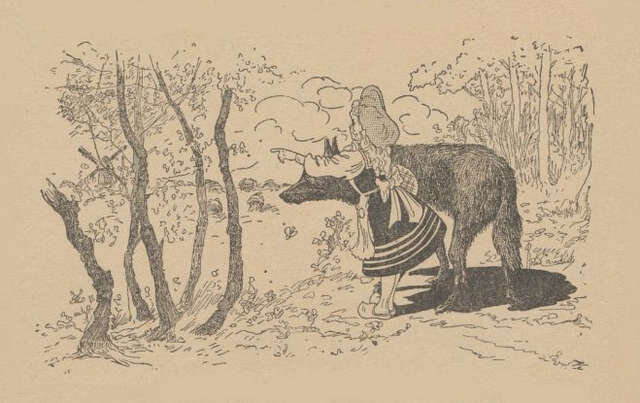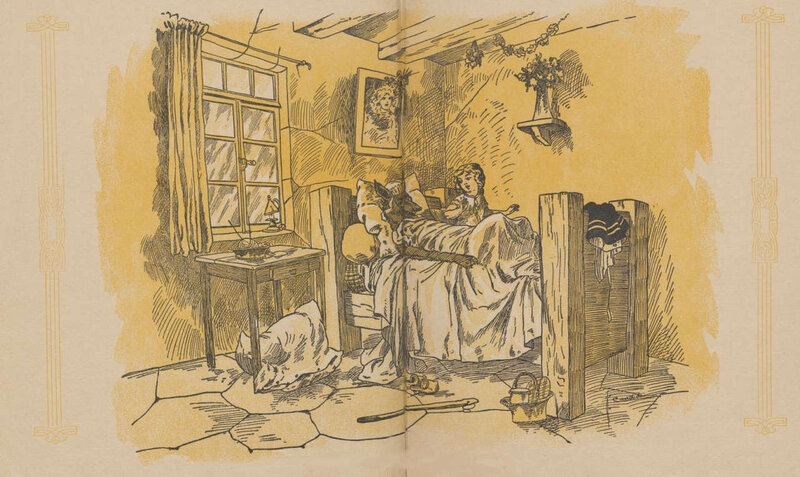Les Contes de Perrault
Charles Perrault wrote some of the most popular fairy tales ever. He was not the original author of Little Red Riding Hodd or The Sleeping Beauty or The Puss in Boots, but it is still more important than ever. than three centuries after Perrault's The Tales were published for the first time.
Numerous illustrators portrayed the scenes and here is one of the books where they were reprinted over and over again. According to the title page, three illustrators made the pictures: A. Robida, E. Tap and R. Candide.
Who were they?
A. Robida is no secret. It stands for Albert Robida, one of the most successful French illustrators of all times.
R. Candide is not very hard to find either. Sometimes also signed as Rose Candide or Pink Candide it was a well-known pseudonym of Edmond Tapissier (1861-1943).
E. Tap is much more mysterious. For some time it was believed it was another pseudonym of Edmond Tapissier. Styles of R. Candide and E. Tap are very similar indeed. But there was also a clerk named Emile Tap (1876-1940), who might be the real illustrator behind the sign. It looks we can’t tell for sure, but we are absolutely positive all presented illustrations are in Public domain in all countries with author’s life + 70 years rule applies.
Enjoy the presentation of the selection of Perrault’s Fairy Tales as they were published by Imagerie merveilleuse de l'enfance in 1941 in Paris.
Le Chat Botte
(Puss in Boots)
This well-known story about the poor boy who inherited the cat which proved to be a very resourceful helper was illustrated by Albert Robida.
Here is the opening scene with a mill, which after the miller’s death became oldest son’s property. The donkey, only other valuable possession went to the second son. The youngest got nothing else but the cat.
At first, he thought the animal would be good enough only for the fur for the gloves, yet the cat convinced him to invest in a pair of boots. After that, a smart plan of climbing up the social ladder starts...
A rabbit was caught by surprise
The cat went straight to the king's palace
The Marquis of Carabas
Help, the Marquis of Carabas is drowning
Good people, you have to tell you are reaping for Marquis de Carabas
The cat was so afraid to see the lion from such close distance
The miller’s youngest son married the princess, got his own castle and thanks to his cat lived happily ever after!
If you are a fan of this particular fairy tale, we have already presented a picture book The Puss in Boots by Richard Andre.
Before we continue, let's answer to an interesting question. Why are Charles Perrault's fairy tales so special?
One of the crucial additions to fairy tales which helped define them as a specific genre is Perrault explicitly written moral at the end. This gave otherwise entertaining stories an educational feel. Thanks to that they eventually started addressing children, not adults - their initial audience. But this happened way after Perrault’s death.
What is the moral of Pus in Boots?
It’s a bit questionable (what is in detail explained here) and says you really need good looks and manners, maybe some nice dresses and even a poor miller’s son can win a heart of the princess!
Le Petit Chaperon Rouge
(Little Red Riding Hood)
One of the most popular stories for children ever is definitely Little Red Riding Hood. It presents a girl who is tricked by the wolf and strays from the path. She and her grandmother became his victims and there is no rescuer in Perrault’s version. As an illustrator, it’s signed Rose Candide.
He decided to start with an almost idyllic scene of the girl leaving her home and going for a visit. Her granny is not feeling well...
When the girl meets the wolf thing started becoming interesting.
It’s down there, says the Little Red Riding Hood
Oh Granny, what big ears you've got!
As we already said, there is no happy ending in Perrault’s story about the Little Red Riding Hood.
Just a moral, in this case, addressing young girls who so often became pray of old powerful men:
Children should never talk to strangers, otherwise, they are risking to become a wolf’s dinner. And the world is full of all sorts of wolves who may even look very gentle. More gentle they are, more danger they present.
(to be continued)
















/https%3A%2F%2Fstorage.canalblog.com%2F89%2F55%2F1589261%2F133585214_o.jpg)
/https%3A%2F%2Fstorage.canalblog.com%2F11%2F01%2F1589261%2F133001925_o.jpg)
/https%3A%2F%2Fstorage.canalblog.com%2F55%2F16%2F1589261%2F127513441_o.jpg)
/https%3A%2F%2Fstorage.canalblog.com%2F81%2F17%2F1589261%2F126599513_o.jpg)